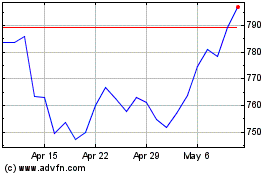The High Cost of Target-Date Funds -- Journal Report
December 04 2020 - 12:00PM
Dow Jones News
By Chana R. Schoenberger
Are investors paying too much for target-date funds?
Target-date funds are designed to give investors a diversified
portfolio that automatically rebalances over time, as a goal like
retirement or college approaches. The funds are growing
increasingly popular, particularly in 401(k) accounts and among
younger investors.
But a new academic paper, released in October but as yet
unpublished, points a finger at the fees that target-date fund
investors pay, which, the researchers calculate, total an average
of one-third of a percentage point annually. Instead of spending
extra to have a target-date fund manage their asset allocation,
investors should replicate the portfolios using cheaper
exchange-traded funds, the authors write in "Off Target: On the
Underperformance of Target-Date Funds."
The problem is that target-date funds are funds that invest in
other funds (known as "funds of funds"), say authors David Brown of
the University of Arizona's Eller College of Management and Shaun
Davies of the Leeds School of Business at the University of
Colorado Boulder. Each fund is a mini-portfolio of underlying
mutual funds and ETFs, and each can levy two levels of fees.
While only about 20% of funds use this arrangement, many 401(k)
investors may be forced to choose them in their portfolio. What's
more, many of the double-fee funds also contain actively managed
funds, which charge more than passive funds because they come with
higher staff costs.
Rare switches
Employees often have their money placed into target-date funds
automatically when they start a new job and launch a new 401(k),
and rarely take the initiative to switch their fund allocation.
"People interpret that as advice and don't change it," Prof.
Davies says.
Because of this inertia, younger investors in particular are
invested heavily in these funds. Among 401(k) account holders in
their 20s, 48% of their retirement savings were held in target-date
funds at the end of 2016, according to the Employee Benefit
Research Institute.
Profs. Brown and Davies identified two causes of target-date
funds' underperformance compared to similarly constructed
portfolios of cheap ETFs: fees and cash drag. The average ETF
portfolio outperformed its mirroring target-date fund by 8 to 11
basis points each month, or 93 to 128 basis points annually,
between 2006 and 2017, the authors found in an analysis
representing what an investor would pay on average if they chose a
target-date fund provider at random.
Most of the underperformance -- two-thirds of the effect -- can
be traced to higher management fees in target-date funds, they
wrote. The funds charged an unnecessary 33 basis points as an
asset-weighted average for 2017 alone, which left investors out of
pocket an extra $2.5 billion, they calculated.
"It is difficult to rationalize that our results simply reflect
[target-date] fund sponsors' operational expenses," they wrote.
These fees do seem to be falling over time as target-date funds
jostle for market share. Vanguard Group, Fidelity Investments,
American Funds, T. Rowe Price and BlackRock -- the five largest
target-date-fund companies, which command the majority of the
market -- don't charge double fees today, says Jason Kephart, a
multiasset-manager research strategist at Morningstar.
"Our target retirement funds do not levy additional fees beyond
the low-cost, underlying index-fund strategies," says Emily
Farrell, a spokeswoman for Vanguard, by far the biggest fund
provider in this area with $907 billion in target-date retirement
assets under management, double its 2016 tally.
Fidelity similarly defends its fees.
"Our target-date-fund pricing is very competitive, with each
Freedom Fund charging shareholders for its operating expenses
directly with a single top-line fee," says Fidelity spokesman Adam
Banker.
Do it yourself?
The paper's authors argue that there's no need to pay even
relatively small fees, since the funds are easy to reproduce on
your own. Each quarter, investors can look at the publicly
disclosed holdings of target-date funds aimed at their projected
retirement year, and adjust their own portfolio of low-cost ETFs
accordingly.
If an investor liked Fidelity's glide paths, or policies for
shifting allocations over time, "they could replicate Fidelity's
glide paths pretty easily," Prof. Brown says.
Ms. Schoenberger is a writer in New York. She can be reached at
reports@wsj.com.
(END) Dow Jones Newswires
December 04, 2020 12:45 ET (17:45 GMT)
Copyright (c) 2020 Dow Jones & Company, Inc.
BlackRock (NYSE:BLK)
Historical Stock Chart
From Mar 2024 to Apr 2024

BlackRock (NYSE:BLK)
Historical Stock Chart
From Apr 2023 to Apr 2024
